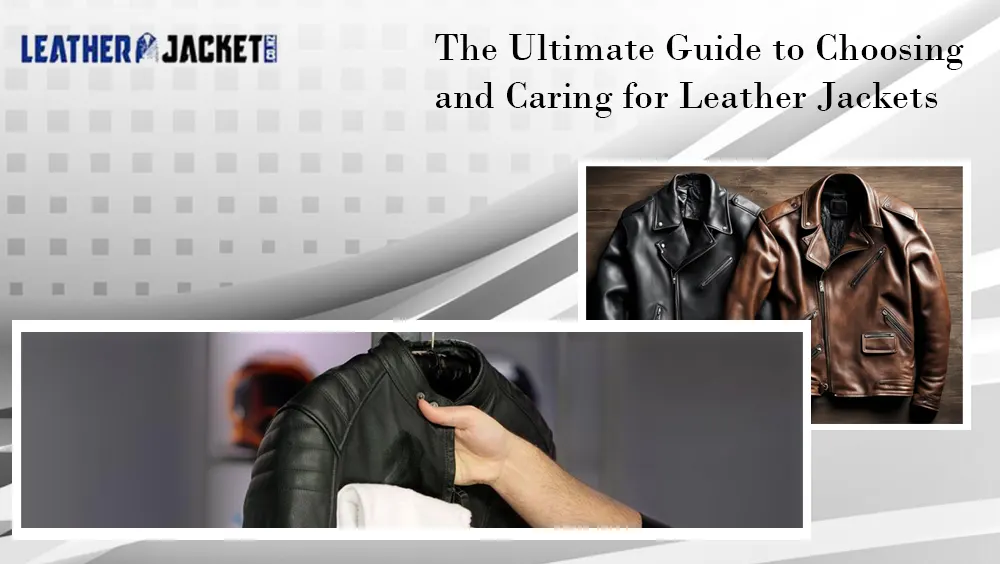Let’s be honest—leather jackets are cool. Always have been, always will be.
Whether it’s a classic biker jacket, a sleek bomber, or a vintage piece passed down from your stylish uncle, leather jackets have a way of making anyone look effortlessly fashionable.
But here’s the thing: not all leather jackets are the same. Also, taking care of one is just as important as choosing the right one. So, whether you’re buying your first leather jacket or looking to keep your old favorite looking fresh, this guide is for you.
Let’s dive into the ultimate guide to choosing and caring for leather jackets—with simple words, fun facts, and practical tips.
Why Leather Jackets Are So Popular
Growing up in New Zealand, I have always wondered why leather jackets are so popular.
Well, a leather jacket shows a sign of going against the rule, trusting oneself, and showing personal feelings. And guess what?
They are not like any ordinary clothing piece that lasts for a few seasons only. Instead, they can make a place in your wardrobe for more than 20 years (if cared for properly).
Hence, Leather Jacket NZ are popular because of their durability, timeless style, versatility, rebellion, and give a sense of confidence.
Different Leathers to Create Jackets
Understanding the different types of leather used to make a jacket is essential.
Below are a few specialty leathers described:
Full-grain Leather
Guys, 100% leather really mean “Full grain.” It is the highest quality of leather referring to the most durable and strongest part of the hide of an animal. In addition, the grain means that no part of the hide has been buffed or sanded. Thus, it has natural imperfections, like scars and wrinkles are visible.
Top-grain Leather
Top-grain leather is a genuine and high-quality leather. In addition, it is created from the top layer of animal hide and sanded to remove all the imperfections, giving a smoother feel. Also, it’s durable and resistant to wear and tear.
Genuine Leather
Genuine leather, despite its name, doesn’t indicate high quality. In addition, products created out of it are made from real animal hide rather than synthetic materials.
Also, it doesn’t offer durability. But since it’s a low-grade material, it’s more affordable.
Faux Leather
It is also known as synthetic or artificial leather. In addition, it is designed to duplicate the feel and look of real leather. It is usually known for being cruelty-free and a budget-friendly option.
Also, people often ask which is best: Genuine leather vs faux leather jackets. Well, this completely depends on the buyer’s needs, ethical considerations, and budget.
Nubuck Leather
Nubuck leather is a type of top-grain cattle leather that is known for its velvety and soft texture. This is achieved by sanding and buffing the outer layer of the leather.
Also, nubuck leather has a degree of water resistance and is durable to wear.
Types of Leather Jackets
Leather jackets come in a variety of styles. In addition, each of them has some unique features that set them apart from others.
The following are the common types of leather jackets:
Biker Jacket
A leather biker jacket or a motorcycle jacket features an asymmetrical zipper, multiple pockets, a snap-down collar, and a slim-fitted silhouette.
According to Buffalo Jackson, this jacket was named by Irving Schott in 1928. In addition, this design became famous among motorcyclists due to its functionality and durability.
Aviator Jacket
An aviator jacket is made from full-grain leather material, which is thick enough to scar. When it comes to their construction, it has long-stitched seams, brushed brass zippers, and ribbed cuffs sealing wrists against the wind.
Bomber Jacket
A leather bomber jacket is an outerwear that originated during World War I. It’s typically waist-length and has a front zipper, waistband, collar, and ribbed cuffs.
In addition, these jackets are super stylish and fit well in both formal and semi-formal occasions.
Cafe Racers Jacket
A cafe racer jacket is known for its sleek, minimalist, and slim fit design. In addition, it’s characterized by a simple, clean look with a front zipper and a stand-up or snap-tab collar.
Puffer Jacket
A puffer jacket is a perfect blend of warmth and puffy design that ensures durability and style of leather. In addition, it features quilted stitching and insulation. Hence, they are the best leather jacket for winter and also provide comfort, warmth, and elements that make you stand out.
Varsity Jacket
A varsity or letterman jacket is often associated with high school and college sports teams. In addition, it’s characterized by a wool body with contrasting full-length sleeves. It also has ribbed cuffs and collar, including patches or letters indicating the team.
How to Choose a Perfect Leather Jacket
Honestly, I always wonder, “How to choose a leather jacket?”
Well, if you’re also like me, consider these elements:
- Consider your body type: Different jacket designs are for different body types. For example, a shorter jacket is more flattering for a tuck-in shirt.
- Snug, but not restrictive: The jacket should fit close to the body without restricting movement. It should feel comfortable from day one and allow for comfortable arm movement.
- Leather quality: According to your needs and budget, look for the best leather quality. Also, make sure to check the quality of a leather jacket before buying.
- Style and color: Black and brown are the classics, but don’t be afraid to try something different. Also, choose a leather jacket style that complements you.
- Care: Think of how you will take care of your jacket to ensure its longevity.
Care and Maintenance of Leather Jackets
After spending sufficient time, you might have chosen the perfect leather jacket according to your requirements, style, and budget.
But simply getting one, wearing it, and throwing it in your wardrobe like a sock is not recommended. Instead, caring for leather jackets is essential to improve their longevity, durability, and texture.
So, let’s find out some helpful leather jacket maintenance tips:
Cleaning Your Leather Jacket
First things first—cleaning your leather jacket is the first step to taking good leather jacket care.
But how to clean leather jackets? With a soap? No.
Use the Right Cleaner
Don’t wash your leather jacket using any ordinary chemical that comes to hand. Instead, you must use the right leather jacket cleaning products to get effective results and reduce damage.
Hence, here’s what you need to know:
- Don’t use harsh chemicals: cleaning your leather jacket with a harsh chemical might instantly remove the surface dirt. But it will also extract the natural oil. Therefore, look for pH-balanced chemicals designed for leather cleaning purposes.
- Trusted brands: You can use Bick 4, Fiebing’s, Saphir, and Lexol formulations. In addition, they are gentle and effective, perfect for both delicate and smooth leathers.
- Leather Conditioners: Apply a conditioner on the leather to restore moisture and suppleness.
A 4-Step Cleaning Process of Leather Jackets
Below are the four must-follow steps to clean your leather jacket:
- Test before applying: To protect leather jacket, always test a small area to make sure that it doesn’t cause discoloration or damage.
- Gentle wiping: improving the leather jacket longevity is essential. And for that, use a soft, damped cloth with the chosen cleaner. In addition, your leather jacket treatment must be soft and delightful. Avoid giving your product a submersion in a bath.
- Deep cleaning: Don’t rush and clean the smaller parts of your jacket. In addition, clean it in circular motions to naturally remove the dirt and save its natural oils.
- Drying: This step needs patience. Let your leather jacket dry naturally at room temperature. Additionally, avoid using hair dryers, radiators, or sunlight. This will dry out your product, and trust me, leather jacket repair after this is a nightmare.
Removing Tough Stains
Tough stains are not easy to remove from leather. But with the right approach, common stains can be managed.
- Blot, Don’t Rub: When something is spilled on your leather jacket, avoid rubbing it. Instead, blot it to absorb the maximum liquid.
- Use baking soda and cornstarch: Spill the baking soda and cornstarch on the affected area and leave it overnight to absorb.
- Seek professional help: If the mess is unmanageable, we suggest getting help from experts.
Conditioning and Moisturizing
Conditioning helps in restoring oils and keeping the leather supple. But before that, you must know some important leather jacket tips regarding conditioning:
When to Condition
How many times should I condition my leather jacket? Well, the frequency depends on the usage and environment.
So, for:
- Daily wear: Condition your leather jacket every few months.
- Exposure: It’s best to condition after a heavy rainfall, saltwater, or extensive exposure to sunlight.
Signs to Notice When Your Leather Jacket Needs Conditioning
Always condition when:
- Dry or feels rough
- Loss of shine or dull appearance
- Stiff or rigid
How to Store Leather Jackets to Avoid Damage
Have you already caused damage to one of your jackets due to improper storage? Well, you must know the leather jacket storage steps.
- Clean it: Obviously, clean your jacket before you store it.
- Stuff it with acid-free paper: Insert the paper in the pocket and sleeves. After that, close the zipper and all the buttons. In addition, this paper helps to protect the shape and creates a barrier for dust, dirt, and moisture.
- Wrap in breathable fabric: Leather needs to breathe. So, wrap it in a white bed sheet or a bag made with netting. NEVER WRAP IT IN PLASTIC. It will dry it out and leave permanent creases.
- Protect it from sunlight: Store your jacket in a cool and dry place to avoid sunlight.
Final Words
Picking the right leather jacket is exciting. Proper care keeps your jacket looking great for years. Treat your leather jacket well, and it becomes a trusted friend. Enjoy your stylish, well-maintained leather.





